You are using an out of date browser. It may not display this or other websites correctly.
You should upgrade or use an alternative browser.
You should upgrade or use an alternative browser.
Howto: Capture Wild Yeast
- Thread starter ericd
- Start date

Help Support Homebrew Talk - Beer, Wine, Mead, & Cider Brewing Discussion Forum:
This site may earn a commission from merchant affiliate
links, including eBay, Amazon, and others.
- Joined
- Apr 18, 2006
- Messages
- 16,779
- Reaction score
- 5,895
Seconded.
++
To what???? A wort sample or a slant?
I see... ericd was talking about my slants. I see no benefit. It would only be a waste unless you want to eat the agar jello after dinner on Sunday.
The yeast just needs food. The hops act as a preservative in beer. I would doubt that adding it (to agar/dme) would have any positive impact. We don't need that on a slant. Its supposed to be sterile. We also want an environment highly conducive to yeast growth.
Bokonon
Well-Known Member
To what???? A wort sample or a slant?
I see... ericd was talking about my slants. I see no benefit. It would only be a waste unless you want to eat the agar jello after dinner on Sunday.
The yeast just needs food. The hops act as a preservative in beer. I would doubt that adding it (to agar/dme) would have any positive impact. We don't need that on a slant. Its supposed to be sterile. We also want an environment highly conducive to yeast growth.
The literature I've read (I can't site an exact source right now) has said that there is a lot of bacteria that won't grow in the presence of alpha acids. So on a plate/slant that is being used to culture wild stuff it would help to only collect/grow things that will grow well in wort.
I've made slants/plates with and without hops and I've never noticed a difference in normal yeast culturing. Though when I've used hopped wort it was always leftover from a batch, so I'll continue to do so when I have leftover wort after a brewday
- Joined
- Apr 18, 2006
- Messages
- 16,779
- Reaction score
- 5,895
I'll consider this for next time. 
- Joined
- Apr 18, 2006
- Messages
- 16,779
- Reaction score
- 5,895
Here's how it looks today.
I captured some of this and put it in a vial of sterile water. I also dropped about 3 loops into a 30ml starter.
It smells tart and a bit fruity. I'm interested in how this growth has layered itself across the slant.
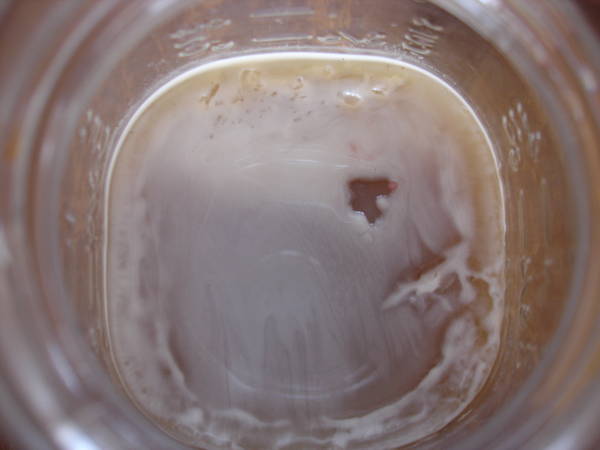
I captured some of this and put it in a vial of sterile water. I also dropped about 3 loops into a 30ml starter.
It smells tart and a bit fruity. I'm interested in how this growth has layered itself across the slant.

- Joined
- Apr 18, 2006
- Messages
- 16,779
- Reaction score
- 5,895
Day 1
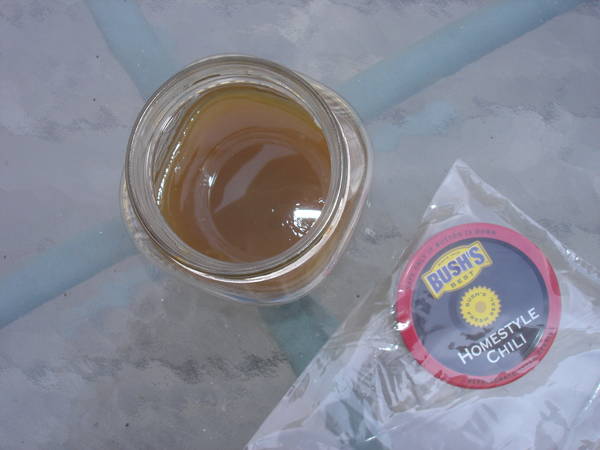
Day 7

Its totally taken over the jar.

All but the bottom has changed color.
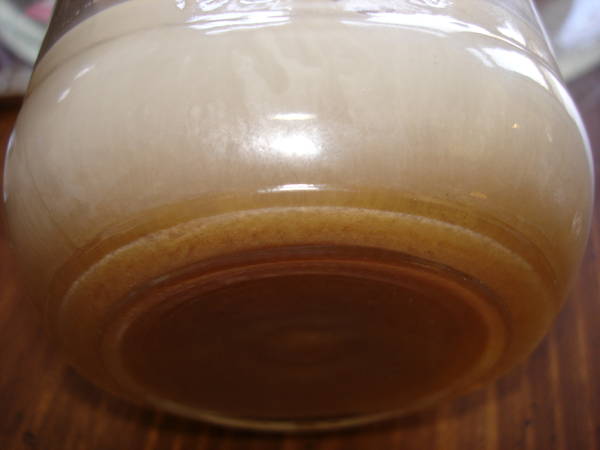

Day 7

Its totally taken over the jar.

All but the bottom has changed color.

- Joined
- Apr 18, 2006
- Messages
- 16,779
- Reaction score
- 5,895
This is the sample in a test tube of sterile water.
MYEAST - 50327 (Pleasant Hill IA Zip Code)
(Pleasant Hill IA Zip Code)
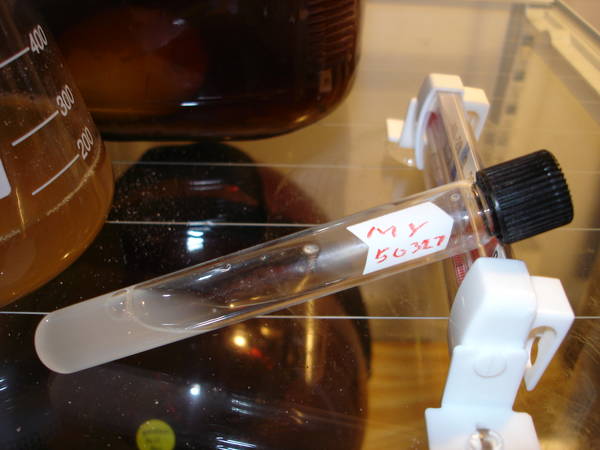
My little 25-30ml starter.
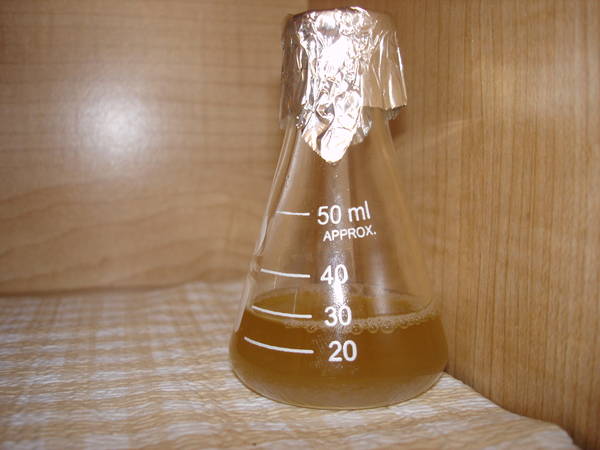
I've got another 150mls ready for my step up...
MYEAST - 50327

My little 25-30ml starter.

I've got another 150mls ready for my step up...
talenos
Well-Known Member
I hear the wild yeast in Southern California smells like nail polish remover, but this would be fun to do.
- Joined
- Apr 18, 2006
- Messages
- 16,779
- Reaction score
- 5,895
I hear the wild yeast in Southern California smells like nail polish remover, but this would be fun to do.
Damn it!! - You made me go sniff the jar 4 times. :cross:
It smells a little like nail polish, fruity and tart. I think the polish smell is the alcohol thats coming up. Would have never thought of nail polish....
Interesting. Traditionally nail polisher remover is acetone. There are biosynthetic routes to form simple ketones such as acetone. I will spare you lot the stream of conciousness gibberish I started to write.Damn it!! - You made me go sniff the jar 4 times. :cross:
It smells a little like nail polish, fruity and tart. I think the polish smell is the alcohol that coming up. Would have never thought of nail polish....
- Joined
- Apr 18, 2006
- Messages
- 16,779
- Reaction score
- 5,895
Interesting. Traditionally nail polisher remover is acetone. There are biosynthetic routes to form simple ketones such as acetone. I will spare you lot the stream of conciousness gibberish I started to write.
Thanks for sparing me the gibberish. My mind going to mush due to the lack of sleep. Need to corral the brain cells that are going to slaughter tonight.
HotbreakHotel
Well-Known Member
I haven't done any sour beer yet, but I have done sauerkraut, sour veggies, pickles, etc. using wild fermentation. And for all of these all I do is put them in brine with no heat at all and they just develop a lactic character on their own. The bugs are not necessarily "caught," as I understand it they are already there in the food.
So I was wondering about taking some organic unmalted barley, crushing it, adding some good water and letting it develop its own indigenous bugs. Just a thought.
I'm also going to try the putting the wort outside thing I've been reading about here. I was going to try boiled and unboiled and see what I get. I'll do it the same way I catch sourdough bugs. I take a canning jar and instead of using the lid I put some cheesecloth over the top and use the ring to secure it. Then I set the jars on the deck. But maybe this time I'll put the jars in the woods on the ground and maybe get "woodsier" bugs!
So I was wondering about taking some organic unmalted barley, crushing it, adding some good water and letting it develop its own indigenous bugs. Just a thought.
I'm also going to try the putting the wort outside thing I've been reading about here. I was going to try boiled and unboiled and see what I get. I'll do it the same way I catch sourdough bugs. I take a canning jar and instead of using the lid I put some cheesecloth over the top and use the ring to secure it. Then I set the jars on the deck. But maybe this time I'll put the jars in the woods on the ground and maybe get "woodsier" bugs!
- Joined
- Apr 18, 2006
- Messages
- 16,779
- Reaction score
- 5,895
Ok - I moved the 25ml starter to the 150ml. Upon doing so it smelled just like the slant, tart, fruity and maybe a bit sour.
I'm not seeing much of the typical yeast action. In the 150ml I have some sediment and it smells about the same.
It doesn't seem behave the same way though.
Question: Is wild yeast NOT Saccharomyces Cerevisiae? Is it usually Brett??
Scratching my head about this....
I'm not seeing much of the typical yeast action. In the 150ml I have some sediment and it smells about the same.
It doesn't seem behave the same way though.
Question: Is wild yeast NOT Saccharomyces Cerevisiae? Is it usually Brett??
Scratching my head about this....
Ok - I moved the 25ml starter to the 150ml. Upon doing so it smelled just like the slant, tart, fruity and maybe a bit sour.
I'm not seeing much of the typical yeast action. In the 150ml I have some sediment and it smells about the same.
It doesn't seem behave the same way though.
Question: Is wild yeast NOT Saccharomyces Cerevisiae? Is it usually Brett??
Scratching my head about this....
I think you usually get both. How much of each, depends on a variety of factors, the area, temperature, season, etc. Complex. There are also other yeasts then just the Sacch. and Bretts. as well.
I think (could be wrong) that the Sacch. produces more esters than the Bretts. So the fruity smell would seem to indicate the presence of Sacch.
Bokonon
Well-Known Member
Ok - I moved the 25ml starter to the 150ml. Upon doing so it smelled just like the slant, tart, fruity and maybe a bit sour.
I'm not seeing much of the typical yeast action. In the 150ml I have some sediment and it smells about the same.
It doesn't seem behave the same way though.
Question: Is wild yeast NOT Saccharomyces Cerevisiae? Is it usually Brett??
Scratching my head about this....
I had just read through something recently that said there are (or were at the time of writing) "100 genera of yeast encompassing 700 species". It also says there are 14 species of Saccharomyces
So there are tons of possibilities of what you could have. Of course that number would be limited down to species that can process maltose (and/or whatever else was in your media)
- Joined
- Apr 18, 2006
- Messages
- 16,779
- Reaction score
- 5,895
I thinking that I should let this go for a bit and then step it up again. Maybe fit an airlock onto it for some time. It appears to be working though. The starters are smelling like the slant.
I was reading about lambics and was thinking this might be a long drawn out process. The slant seemed to grow fast though...
Can't tell the actvity w/o a gravity check or fitting an airlock.
I was reading about lambics and was thinking this might be a long drawn out process. The slant seemed to grow fast though...
Can't tell the actvity w/o a gravity check or fitting an airlock.
Bokonon
Well-Known Member
I thinking that I should let this go for a bit and then step it up again. Maybe fit an airlock onto it for some time. It appears to be working though. The starters are smelling like the slant.
I was reading about lambics and was thinking this might be a long drawn out process. The slant seemed to grow fast though...
Can't tell the actvity w/o a gravity check or fitting an airlock.
This is all pretty knew to me, but I'm enjoying reading/learning about all of this. I'll probably try to do something like this sometime soon.
If you isolate a single colony you could make some small vials of wort of differing gravity to see at what point the strain dies off. Maybe in steps of 20 points. 1.020, 1.040, 1.060, 1.080, 1.100, 1.120. With small sizes it should be cheap enough to make with DME
- Joined
- Apr 18, 2006
- Messages
- 16,779
- Reaction score
- 5,895
The literature I've read (I can't site an exact source right now) has said that there is a lot of bacteria that won't grow in the presence of alpha acids. So on a plate/slant that is being used to culture wild stuff it would help to only collect/grow things that will grow well in wort.
I've made slants/plates with and without hops and I've never noticed a difference in normal yeast culturing. Though when I've used hopped wort it was always leftover from a batch, so I'll continue to do so when I have leftover wort after a brewday
Just an FYI....
I did do some research on this. Adding hop extract would be better than hop pellets. Mainly because of the homogeneous appearance of the slant. You need to be able to visually single out the bugs or mold on a slant. Not mistake bugs for hop particles or vice-versa.
I believe you would be correct in the benefit of adding AA's as would adding some yeast nutrients. I usually add the latter to my media.
I will keep your idea in mind with using leftover wort. I usually make media up from extra-light DME.
- Joined
- Apr 18, 2006
- Messages
- 16,779
- Reaction score
- 5,895
Starter Update...
This is stepped up twice close to about a liter. Should be good for my 3 gal batch.
The smell & appearance between steps are the same and it appears to clear well.
So Far, So Good.
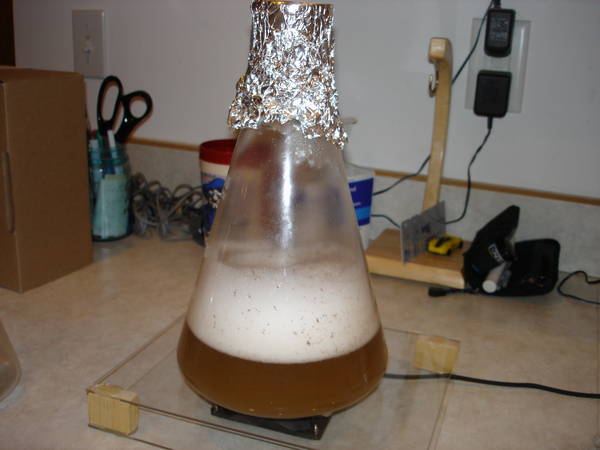
This is stepped up twice close to about a liter. Should be good for my 3 gal batch.
The smell & appearance between steps are the same and it appears to clear well.
So Far, So Good.

Cookiebaggs
Well-Known Member
This is really cool Schlenkerla!
Thanks for taking the pics and logging your progress.
I assume you are brewing this weekend?
Thanks for taking the pics and logging your progress.
I assume you are brewing this weekend?
- Joined
- Apr 18, 2006
- Messages
- 16,779
- Reaction score
- 5,895
This is really cool Schlenkerla!
Thanks for taking the pics and logging your progress.
I assume you are brewing this weekend?
No probably not. My parents are coming to visit. They want to see their grand child. Maybe Sunday.
I don't know how fast this yeast is at chugging away on malt, so a little longer time on the stir plate is no big deal IMO.
So I tried the wild yeast capturing thing with DME wort where in Salt Lake. It seems to be working, albeit slowly. I'll be scaling up soon and brewing with it next weekend. One strange thing though, it is producing an odd chemical smell. The closest thing I can think that it smells like is ethyl methyl ketone but that is not quite right. Hmm...
KingBrianI
Well-Known Member
Well when I brewed my British Special Dark a few weeks ago I took a rather large hydrometer sample and instead of drinking it like usual, I left it in a glass in the kitchen uncovered. The next day I put aluminum foil over the top and like that it has been since. In a couple days, it had developed a bit of what looked like yeast around the edges on the top but when I smelled it, it had quite a funk. The ring of gunk has since given way to what appears to be a small kreuzen and the smell has become strongly belgian. It's all very exciting.
This glass, still sitting in my kitchen, has continued to develop very belgian-y aromas without molding over or turning funky, so tonight I brewed up a simple 1 gallon recipe with DME to pitch the glass into. I'm really looking forward to seeing how it comes out. I was aiming for a kind of simple belgian golden ale to highlight the yeast flavors without overwhelming them with anything else. Here is what it was:
OG 1.062
IBU 27
1 lb. light DME
0.25 lb. wheat DME
0.125 lb. table sugar
0.3 oz. New Zealand Hallertau (8.6%) 20 min
This is exciting!

- Joined
- Apr 18, 2006
- Messages
- 16,779
- Reaction score
- 5,895
Go, Go, Go Mystery Yeast!!! 







I got all inspired and went out and captured a nose smelling will yeastlast week, just before it started to warm up. The start smelled quite bready but now has a bit of tartness to it as well. It seems to need cooler temps so I will most likely start it cool. Or perhaps do 2 batches, one in the cellar and one in the frige.
Anyway, thanks for all the great tips.
I still think this thread needs a sticky.
Anyway, thanks for all the great tips.
I still think this thread needs a sticky.
- Joined
- Apr 18, 2006
- Messages
- 16,779
- Reaction score
- 5,895
The closest thing I can think that it smells like is ethyl methyl ketone but that is not quite right. Hmm...
Converted that into layman's terms....
Butanone - Wikipedia, the free encyclopedia
Butanone is the organic compound with the formula CH3C(O)CH2CH3. This colorless liquid has a sharp, sweet odor reminiscent of butterscotch and acetone. It is a ketone, better known as methyl ethyl ketone or MEK. It is produced on a large scale industrially. Butanone occurs in only trace amounts in nature.[2]
- Joined
- Apr 18, 2006
- Messages
- 16,779
- Reaction score
- 5,895
Well I brewed this yesterday. All Grain Stove Topper (Only 3 gal)
Its been 14 hours and the air lock is bubbling away! :rockin:
Iowa Wild Wheat (Pseudo-French/Belgian Something or Other??)
A ProMash Recipe Report
Recipe Specifics
----------------
Batch Size (Gal): 3.00 Wort Size (Gal): 3.00
Total Grain (Lbs): 5.26
Anticipated OG: 1.052 Plato: 12.86
Anticipated SRM: 6.6
Anticipated IBU: 14.6
Brewhouse Efficiency: 75 %
Wort Boil Time: 60 Minutes
Grain/Extract/Sugar
% Amount Name Origin Potential SRM
-----------------------------------------------------------------------------
38.0 2.00 lbs. Pale Malt(6-row) America 1.035 2
38.0 2.00 lbs. Flaked Soft White Wheat America 1.034 2
19.0 1.00 lbs. Cane Sugar Generic 1.046 0
2.5 0.13 lbs. Special B Malt Belgian 1.030 120
2.5 0.13 lbs. Victory Malt America 1.034 25
Potential represented as SG per pound per gallon.
Hops
Amount Name Form Alpha IBU Boil Time
-----------------------------------------------------------------------------
0.50 oz. Saazer Pellet 3.60 14.6 60 min.
Yeast
-----
Myeast 50327 Wild Mystery
Mash Schedule
-------------
Mash Type: Single Step
Grain Lbs: 4.26
Water Qts: 4.26 - Before Additional Infusions
Water Gal: 1.07 - Before Additional Infusions
Qts Water Per Lbs Grain: 1.00 - Before Additional Infusions
Saccharification Rest Temp : 148 Time: 60
Mash-out Rest Temp : 158 Time: 10
Sparge Temp : 170 Time: 10
Total Mash Volume Gal: 1.41 - Dough-In Infusion Only
All temperature measurements are degrees Fahrenheit.
Its been 14 hours and the air lock is bubbling away! :rockin:
Iowa Wild Wheat (Pseudo-French/Belgian Something or Other??)
A ProMash Recipe Report
Recipe Specifics
----------------
Batch Size (Gal): 3.00 Wort Size (Gal): 3.00
Total Grain (Lbs): 5.26
Anticipated OG: 1.052 Plato: 12.86
Anticipated SRM: 6.6
Anticipated IBU: 14.6
Brewhouse Efficiency: 75 %
Wort Boil Time: 60 Minutes
Grain/Extract/Sugar
% Amount Name Origin Potential SRM
-----------------------------------------------------------------------------
38.0 2.00 lbs. Pale Malt(6-row) America 1.035 2
38.0 2.00 lbs. Flaked Soft White Wheat America 1.034 2
19.0 1.00 lbs. Cane Sugar Generic 1.046 0
2.5 0.13 lbs. Special B Malt Belgian 1.030 120
2.5 0.13 lbs. Victory Malt America 1.034 25
Potential represented as SG per pound per gallon.
Hops
Amount Name Form Alpha IBU Boil Time
-----------------------------------------------------------------------------
0.50 oz. Saazer Pellet 3.60 14.6 60 min.
Yeast
-----
Myeast 50327 Wild Mystery
Mash Schedule
-------------
Mash Type: Single Step
Grain Lbs: 4.26
Water Qts: 4.26 - Before Additional Infusions
Water Gal: 1.07 - Before Additional Infusions
Qts Water Per Lbs Grain: 1.00 - Before Additional Infusions
Saccharification Rest Temp : 148 Time: 60
Mash-out Rest Temp : 158 Time: 10
Sparge Temp : 170 Time: 10
Total Mash Volume Gal: 1.41 - Dough-In Infusion Only
All temperature measurements are degrees Fahrenheit.
- Joined
- Apr 18, 2006
- Messages
- 16,779
- Reaction score
- 5,895
BTW - It has no krausen on top of the wort..... 
KingBrianI
Well-Known Member
BTW - It has no krausen on top of the wort.....
I wasn't expecting much of one on mine because when I caught it it just seemed to form a little bit of a layer on top with some large bubbles around the sides. Because of that I filled the one-gallon bottle I'm fermenting in nearly full of wort. The yeast decided to produce a very unique krausen though, a pillowy, bright white fluff of bubbles with no grayish or brownish colors like a typical krausen. It also has a constant stream of bubbles coming up from a cake on the bottom, much like it looks like when you make apfelwein with montrachet yeast. The smell is nowhere near as funky as it was before pitching. It actually has only a slight belgian-ester aroma with lots of light floral and fruit smells. I'm guessing either the funk will come later or that the non-funk producing yeast has outcompeted the funky yeast. Either way the experiment is still very exciting.

- Joined
- Apr 18, 2006
- Messages
- 16,779
- Reaction score
- 5,895
That's interesting. I was starting to think it might behave like a wine yeast. Mine is still chuggin' kind of slow. Its 62F in the basement.
I noticed that I have about 1" layer of sediment in my carboy. I can't smell anything either, other than iodophor in the airlock.
I'll have to wait a bit. I've acknowledged that this could be a long ferment. Who knows in 24-48 hours it could be going gonzo like Montrachet.
I got about teaspoon or so out of my starter, what was leftover after dumping it into the carboy. It was a bit sweet, in fact kind of clean, no sourness to speak of taste-wise.
I noticed that I have about 1" layer of sediment in my carboy. I can't smell anything either, other than iodophor in the airlock.
I'll have to wait a bit. I've acknowledged that this could be a long ferment. Who knows in 24-48 hours it could be going gonzo like Montrachet.
I got about teaspoon or so out of my starter, what was leftover after dumping it into the carboy. It was a bit sweet, in fact kind of clean, no sourness to speak of taste-wise.
Cool guys! The internet's been down here for the past 3 days so I haven't been able to post. I meant to save a little wort to capture some new yeast out in the country from the batch I did a week ago, but I forgot when the time came!!!!! Grrrr! So mad!
- Joined
- Apr 18, 2006
- Messages
- 16,779
- Reaction score
- 5,895
My beer is starting to show signs of floaties. Not sure what to make of it, pellicle or yeast. I'm thinking the latter.
(Edit: 3/25/08 - Actually, I think they are hop particles.)
(Edit: 3/25/08 - Actually, I think they are hop particles.)
- Joined
- Apr 18, 2006
- Messages
- 16,779
- Reaction score
- 5,895
My beer is cranking away slowly, its passing a CO2 bubble every 15 seconds, temp is 66F. 2.5 days from pitching ~ 60hrs
I was hoping for a raging ferment.
I guess one bubble every 15s is not bad.
I was hoping for a raging ferment.
I guess one bubble every 15s is not bad.
KingBrianI
Well-Known Member
Since I don't have stoppers to fit my 1 gallon bottles mine is just covered with some sanitized aluminum foil but the ferment was pretty vigorous up until about yesterday. The krausen has gone down a bit but there are still tons of bubbles coming up in little strings all over. The fermentation has strangely started producing very little aroma. The fruit and floral smells that were there are now all but gone.
- Joined
- Apr 18, 2006
- Messages
- 16,779
- Reaction score
- 5,895
Hey quick update. My wild wheat cranked away slowly for 5 days, stopped for three days and is now cranking away. Something else took over.
Its got some weird krausen going but I think most of the yeast is on down on the bottom.
All I can say is "Freakin' Awesome!". :rockin:
[ame=http://www.youtube.com/watch?v=inbD3VjZZWE]YouTube - Wild Wheat In Action[/ame]
Its got some weird krausen going but I think most of the yeast is on down on the bottom.
All I can say is "Freakin' Awesome!". :rockin:
[ame=http://www.youtube.com/watch?v=inbD3VjZZWE]YouTube - Wild Wheat In Action[/ame]
- Joined
- Apr 18, 2006
- Messages
- 16,779
- Reaction score
- 5,895
Which one makes you want to gag?
A) Wild Yeast Shot #1
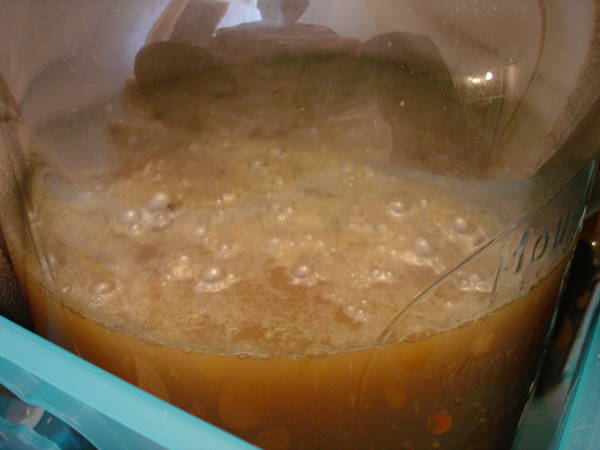
B) Wild Yeast #2
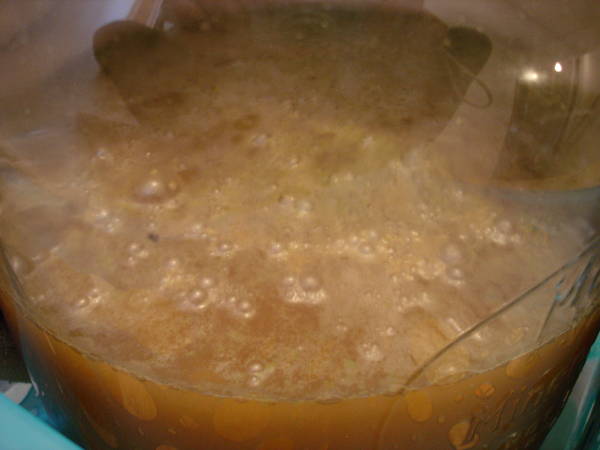
C) Wild Yeast #3
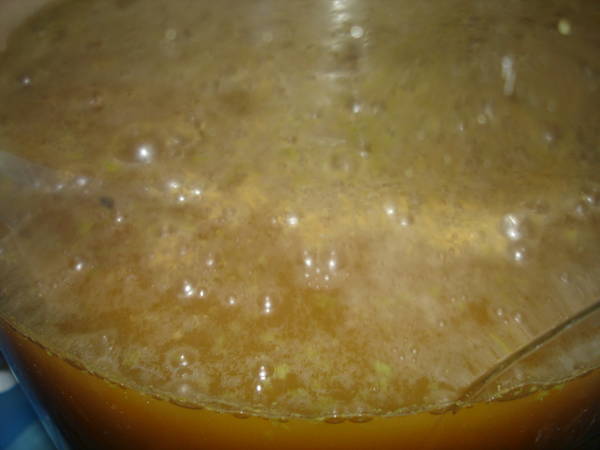
D) Wild Beast #4
A) Wild Yeast Shot #1

B) Wild Yeast #2

C) Wild Yeast #3

D) Wild Beast #4
KingBrianI
Well-Known Member
dude, she's got balls!
Bokonon
Well-Known Member
Number 4, does not belong in my beer! (Although I wouldn't mind eating it!)
I think the pic and quote needs to be preserved forever!
- Joined
- Apr 18, 2006
- Messages
- 16,779
- Reaction score
- 5,895
I think the pic and quote needs to be preserved forever!
No Kidding. The correct answer is D. She forgot to tuck the balls.
Similar threads
- Replies
- 10
- Views
- 865

